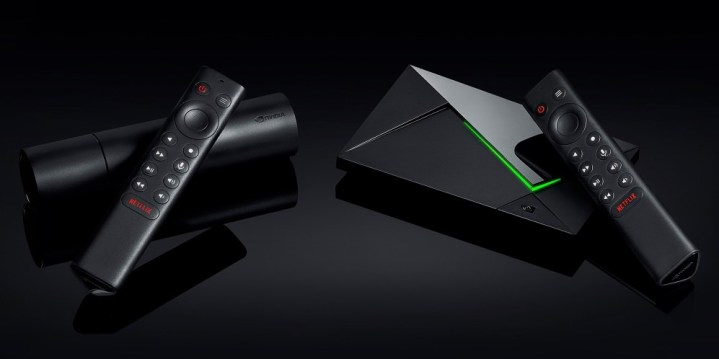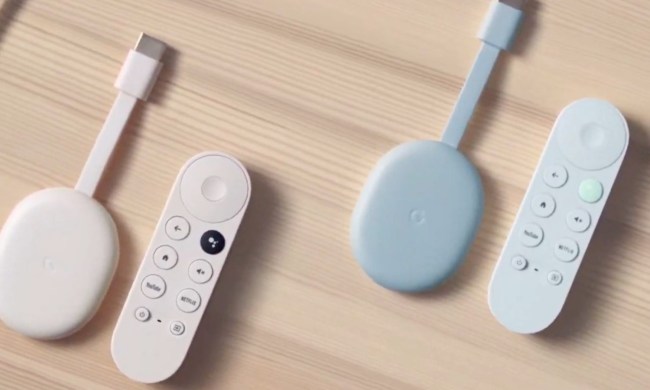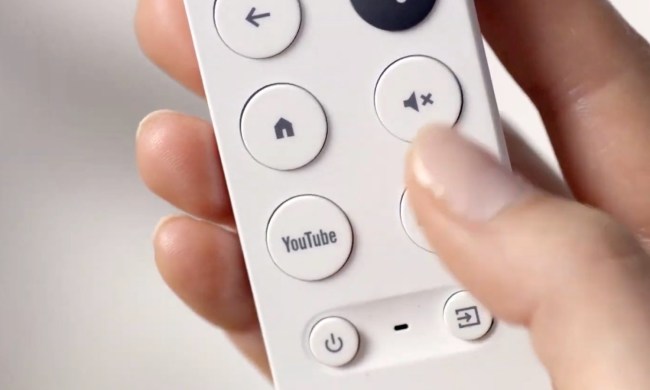
Recent glitches on Amazon and NewEgg gave away most of the surprise factor, but now we know for sure: Nvidia has just refreshed its Shield TV lineup with two new models: The Shield TV and Shield TV Pro. The updated models have Dolby Vision, a faster processor, and an all-new remote control, starting at $150.
The $150 Nvidia Shield TV features an unusual cylindrical shape with ports at both ends. Nvidia claims the design was chosen as a compromise of sorts: It’s small enough to be tucked away if you don’t want to see it, but it doesn’t use the typical dongle format of some other small media streamers as this would impact the quality of its wireless networking. It supports Dolby Vision, something that was lacking from previous versions of the product. The new, smaller form factor ditches the two USB 3.0 ports from the 2017 model but adds a MicroSD card slot. Nvidia believes that this model will appeal more to those who simply want a really good streaming experience, so some features (like the USB ports) were removed to achieve a lower price. At $150, the new Shield TV is $30 less expensive than the lowest-priced Apple TV 4K.
Inside, an Nvidia Tegra X1+ CPU powers the show. Nvidia claims this delivers 25% faster performance. RAM is smaller than previously reported at 2GB but storage drops from 16GB to just 8GB.

In addition to the Dolby Vision HDR support, Nvidia has introduced a new A.I.-powered upscaling feature for content that is not natively 4K. It claims that this upscaling system uses machine learning to provide much sharper imagery through real-time analysis of each frame, something that other upscaling systems on media streamers don’t do.
The other big change is the remote control. Until now, Shield TV remotes have been thin, minimalist affairs, following the model favored by Apple of pairing a directional pad and volume slider, with a back button, a home button, and a dedicated voice assistant button. The new remote is a significant departure from this approach. It uses a Toblerone-like triangular shape and adds more dedicated buttons such as play/pause, power, fast-forward, and rewind. It has a motion sensor that triggers backlit illumination for the buttons when the remote is picked up. The new remote is also backward compatible with previous Shield TV models and will be available for purchase separately later.
Built-in IR gives the remote the ability to control third-party TVs and other devices without relying on HDMI-CEC.
The $200 Shield TV Pro has most of the same features of the Shield TV but uses the chassis from the Shield TV 2017 model. It gets 16GB of storage, 3GB of RAM, and the same USB 3.0 ports that were on the previous model. A vertical stand remains an optional add-on. Unlike the previous Shield TV Pro which was released in 2015, the new Pro does not ship with Nvidia’s game controller. The company has recognized that many of its customers already own controllers that they enjoy using, and the Shield TV Pro can be paired with either Sony’s DualShock 4 controller or an Xbox One wireless controller. Nvidia’s controller is still available for those who want to buy one separately.
The new Shield TV and Shield TV Pro are available on Nvidia’s website as well as Amazon.com.



